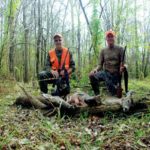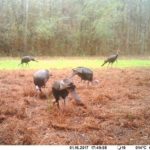
Indications are 2016 deer season was a good one
The January issue of the Louisiana Sportsman had the words “finish strong” on the cover. This was in reference to the idea that January is the peak rut month for Areas 1 and 6, the land of the big bucks in the Bayou State.
The February issue had photographs of big deer, harvested primarily from Area 2. The photographs are proof that some very nice bucks were harvested this past season.
The rut in Area 2 appeared to be right on target, as predicted in this magazine months ago.
The Sportsman Show in Gonzales during mid-March will be the test of how good the quality of the harvest was.
There was lots of excitement about a potential state-record typical being harvested. The score was 188 as estimated by the Simmons store in Bastrop.
However, as I always tell people who have their deer scored in this contest, don’t expect that score to hold up when it is officially measured according to Boone and Crockett standards. One big reason is that the score assigned to the deer is a gross score, with no deductions for lack of symmetry.
If you were blessed to kill a good buck this past season, let me encourage you to bring it to the contest. Anyone who enters any size buck is eligible to win the grand prize: a Yamaha ATV.
Of course, do not expect a small buck to win one of the categories.
A score of 110 inches for a Louisiana buck killed with bow and arrow qualifies for listing in the state records. A buck scoring 130 or better will make the 2016 Big Buck List, as prepared by LDWF at the end of each season, and will be placed on their website for viewing.
To make the Louisiana state list in the typical category, a buck has to score 160. This score would qualify a deer for entry into the Boone and Crockett Awards Program.
A buck killed with bow and scoring 125 or better in the typical category qualifies for listing in the Pope and Young Record Book.
For the most part, all bucks will be scored, except those that won’t break 100, so it will be interesting to see what the quality of the 2016 state kill is.
The longest drag
My friend Mark Bible and I had a good season on Pearl River WMA. We both killed hogs during the early primitive season, but did not have much luck during the either-sex or bucks-only season.
Low water conditions in the swamp had the game pretty much staying in the lower mud swamp during the day and then moving up to the oak ridges at night to feed.
We were seeing the buck sign slowly increase each week during December. The last two weeks of December was a primitive deer season on the area, and we hunted that last weekend. I had received numerous text photos from friends that week with nice bucks they had harvested, and I told Mark someone would kill a deer that day.
If you read my column last month, you know I had written about the Perch Lake Road and crossing the Double Log Slough. Well, on this morning I headed south toward that slough, but was not going any farther.
I stopped at a small slough and saw a nice rub on the other side; about 30 feet away was another rub, and I was thinking this was a rub line of a buck.
A deer suddenly appeared in front of me near the first rub, and I my rifle raised and fired. The deer jumped and ran off.
I eased over to where the deer had been standing, and found blood and lung material on the ground. The .444 had done what it usually does, and I knew the deer had not gone far.
I had heard a shot about 15 minutes earlier, and as I was following the blood when Mark texted me that he had a 3-point on the ground.
I told him I was on a blood trail, and about five minutes later sent a text that I had a good spike.
He texted that he had a 30-minute drag to the boat; I replied mine was much longer.
At the halfway point of my drag, which was a series of leap-frogging — tote the gun and backpack ahead, and then go back and drag the deer, and so on — I was resting by the familiar overcup oak with the large 90-degree branch when I looked out into the woods and saw a brown body.
I picked up the rifle and began slipping toward it.
During the primitive season a hunter can kill an antlered and an antlerless deer. I was scoping it out when my phone rang, and Mark advised he was at the boat with his deer and would head my way.
I told him my situation, put the phone down, determined it was an antlerless deer and pulled the trigger. The deer hit the ground and more work began.
It wasn’t long before Mark arrived, and now we both were dragging deer and gear.
My drag began at 8 a.m. and ended at 12:15 p.m. When I told some friends my story, they said it wasn’t worth all that work for a deer.
I was thinking that during my drag, but once it was over, I was ready to do it again.
Mark and I ended our deer hunting on Pearl during the quality hunt, with a nice pig for each of us. The water had finally come up, and the hogs were on the high ground.
LDWF is doing away with the quality hunt on Pearl, which is good because Pearl is not the place to be trying to count four points on one side, but we hope they give us some time during another season to hunt deer.
Now is the time to give your comments about the 2017-18 hunting season to LDWF and let your voice be heard.
Time to talk turkey
The turkey season begins this month, and hopefully you have done the work needed to attract the turkeys. Some green fields of wheat and clover will help draw the birds in during the spring, and hopefully you did this last fall.
There are some changes for the 2018 turkey season, so you need to check out the regulations — and, again, attend a public meeting and speak your peace.
Some of the outdoor stores will be having turkey seminars prior to the season, and that would be a good opportunity to visit with the expert turkey callers and learn a few tricks.
Good hunting and be safe.




